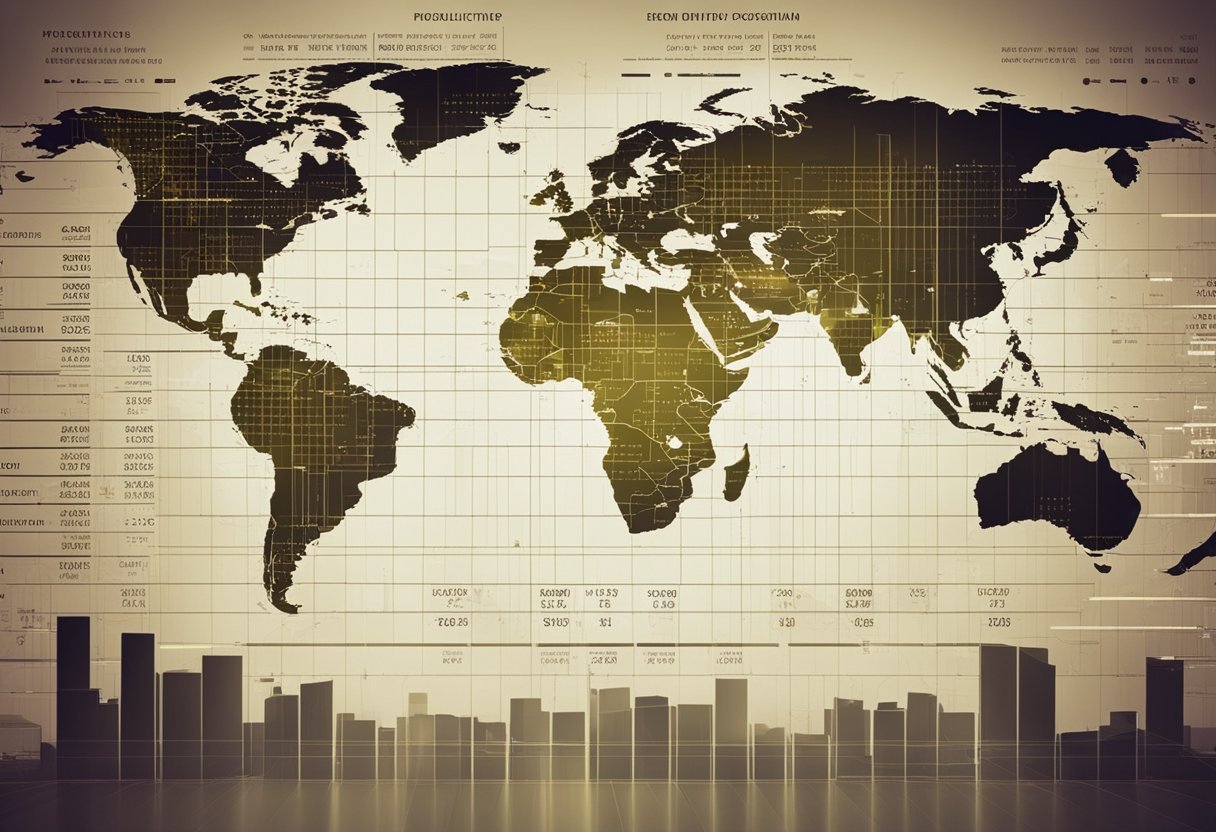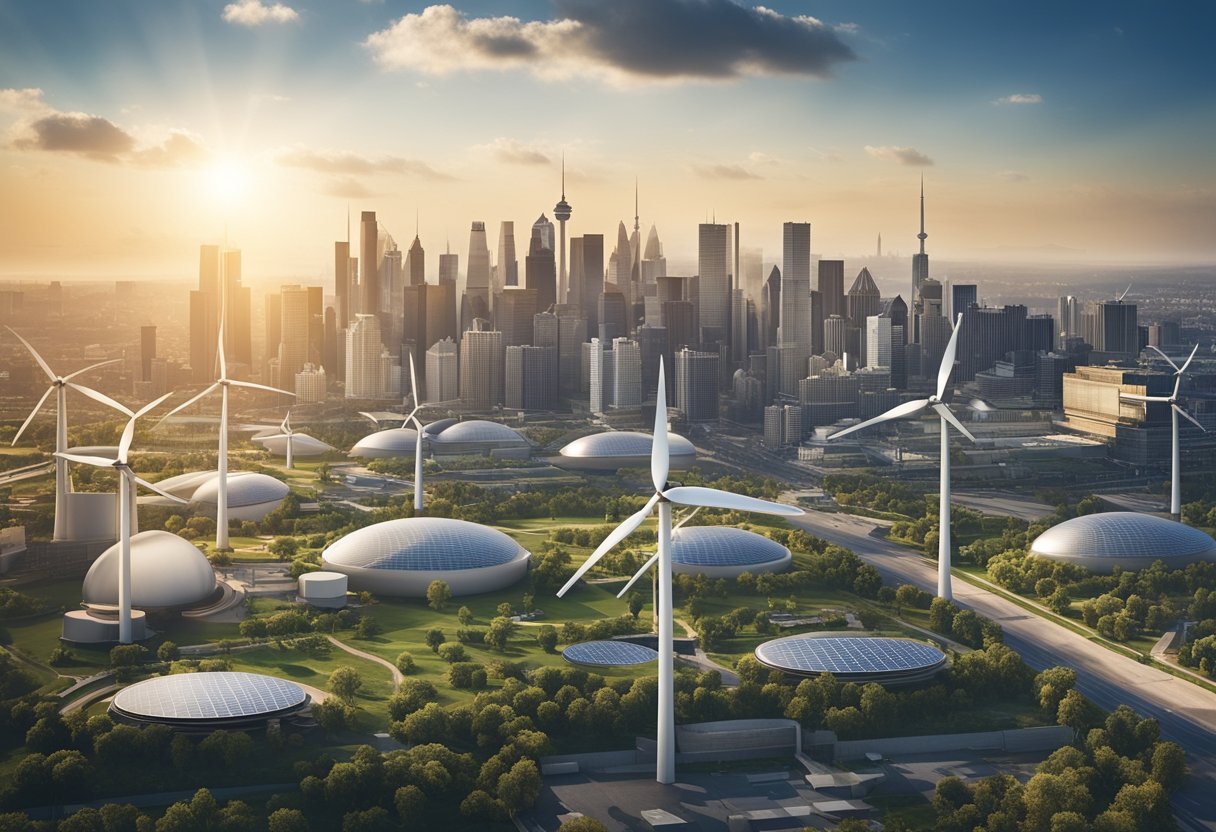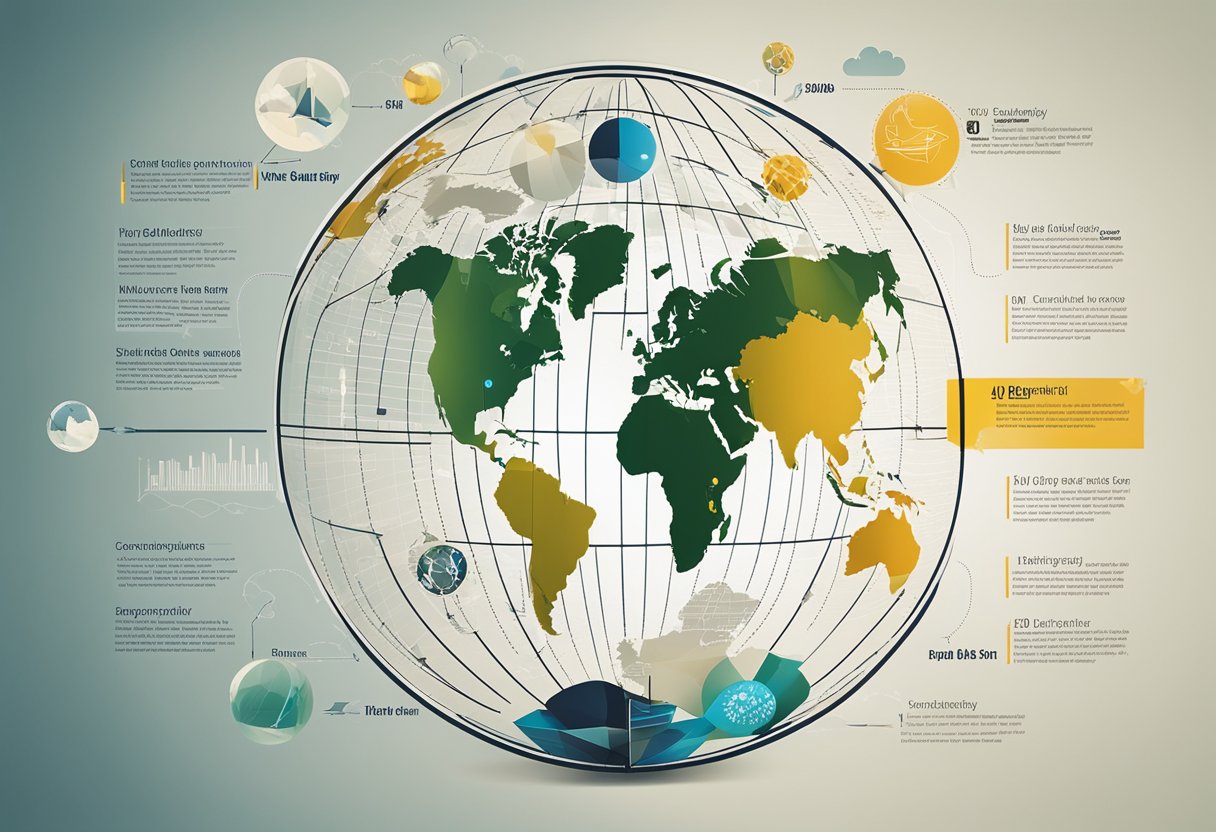The Global Energy Markets have a significant impact on the global economy and energy security. The study of these markets is essential for understanding the dynamics of energy production, consumption, and trade. The global energy markets are constantly evolving due to the energy transition, which is the shift from traditional fossil fuels to renewable energy sources. This transition is driven by a combination of technological, economic, and environmental factors.

Studying the global energy markets involves analyzing various factors, such as supply and demand, pricing, policies, and regulations. It also involves examining the interactions between different energy sources, such as oil, gas, coal, nuclear, and renewables. Understanding these interactions is crucial for predicting future trends and identifying opportunities and risks in the energy sector.
In recent years, the global energy markets have witnessed significant changes, such as the rise of shale gas, the growth of renewable energy, and the emergence of new energy technologies. These changes have created new challenges and opportunities for energy producers, consumers, and policymakers. Therefore, studying the global energy markets is essential for ensuring energy security, promoting sustainable development, and achieving global climate goals.
Overview of Global Energy Markets

Global energy markets are complex systems that involve the production, trade, and consumption of various energy commodities. These markets are influenced by a range of economic and geopolitical factors, making them highly dynamic and subject to rapid change. In this section, we will provide an overview of the key energy commodities, market dynamics and trade flows, and economic and geopolitical influences that shape global energy markets.
Key Energy Commodities
The primary energy commodities traded in global markets include oil, gas, coal, and electricity. These commodities are produced and consumed on a large scale, and their prices are influenced by a range of factors, including supply and demand, geopolitical tensions, and technological advancements.
Oil is the most widely traded energy commodity in the world, with prices that are closely watched by investors, policymakers, and consumers alike. Gas and coal are also important energy commodities, particularly in regions where they are abundant and can be produced at low cost. Renewable energy sources, such as wind, solar, and hydroelectric power, are also gaining traction in global energy markets, as countries seek to reduce their dependence on fossil fuels and transition to cleaner energy sources.
Market Dynamics and Trade Flows
Global energy markets are subject to a range of market dynamics and trade flows that influence the prices of energy commodities. These dynamics include changes in supply and demand, geopolitical tensions, and technological advancements.
Changes in supply and demand can have a significant impact on energy prices, particularly in the short term. For example, a sudden increase in demand for oil can lead to a spike in prices, while a sudden increase in supply can lead to a drop in prices.
Geopolitical tensions can also have a significant impact on global energy markets. For example, tensions between major oil-producing nations can lead to disruptions in supply, which can cause prices to rise. Technological advancements, such as the development of new drilling techniques or the increased use of renewable energy sources, can also have a significant impact on global energy markets.
Economic and Geopolitical Influences
Global energy markets are also influenced by a range of economic and geopolitical factors. These factors include changes in global economic growth, shifts in trade patterns, and geopolitical tensions.
Changes in global economic growth can have a significant impact on energy prices, particularly in developing countries where energy consumption is growing rapidly. Shifts in trade patterns can also have a significant impact on global energy markets, particularly in regions where energy commodities are traded on a large scale.
Geopolitical tensions can also have a significant impact on global energy markets, particularly in regions where energy commodities are produced or transported. For example, tensions between major oil-producing nations can lead to disruptions in supply, which can cause prices to rise. Similarly, tensions between major energy-consuming nations can lead to changes in trade patterns, which can also impact energy prices.
Energy Sources and Technologies

The global energy markets are constantly evolving, with new technologies and innovations emerging every year. In this section, we will explore the various energy sources and technologies that are currently shaping the global energy landscape.
Fossil Fuels and Their Impact
Fossil fuels, such as coal, oil, and natural gas, have been the primary source of energy for decades. However, their impact on the environment has become a major concern. The burning of fossil fuels releases greenhouse gases, which contribute to climate change and air pollution. Despite this, fossil fuels continue to dominate the energy markets due to their affordability and reliability.
Renewables and Clean Energy Innovations
Renewable energy sources, such as solar, wind, and hydro power, have gained popularity in recent years due to their clean and sustainable nature. These sources of energy are becoming more affordable and efficient, making them a viable alternative to fossil fuels. In addition, there are numerous clean energy projects and innovations being developed, such as carbon capture and hydrogen fuel cells, that have the potential to revolutionize the energy industry.
Nuclear Energy and Emerging Technologies
Nuclear energy is another source of energy that has the potential to provide clean and reliable power. However, nuclear power plants can be costly and pose safety concerns. Despite this, there are emerging technologies being developed, such as small modular reactors and advanced nuclear fuel cycles, that could make nuclear energy more accessible and safer.
Overall, the global energy markets are shifting towards cleaner and more sustainable sources of energy. While fossil fuels will continue to play a role in the energy landscape, it is clear that renewables and emerging technologies will be key players in the future of energy.
Energy Policy and Economics

The global energy markets are influenced by various factors, including investment strategies, regulatory frameworks, and economic impact. Understanding the interplay between these factors is crucial for policymakers, investors, and other stakeholders seeking to navigate the complex energy landscape.
Investment Strategies and Market Stimulation
Investment in energy markets is driven by a range of factors, including fuel prices, technological advancements, and policy enforcement. Governments and private investors alike seek to identify profitable opportunities while minimizing risk. Market stimulation is a key strategy for encouraging investment in renewable energy. This can involve subsidies, tax incentives, and other measures aimed at reducing the costs of renewable energy production.
Regulatory Frameworks and Climate Agreements
Regulatory frameworks play a crucial role in shaping the energy markets. Governments use regulations to promote energy efficiency, reduce emissions, and ensure the safety of energy production and consumption. The Paris Agreement, signed in 2015, is a landmark climate agreement aimed at reducing global greenhouse gas emissions. The agreement has implications for the energy markets, as countries seek to meet their emissions targets through a range of measures, including increased investment in renewable energy.
Economic Impact of Energy Markets
The energy markets have a significant impact on national and global economies. Energy prices can affect inflation and economic growth, while energy investments can drive job creation and economic development. The global GDP is also influenced by energy markets, as countries seek to secure reliable and affordable energy supplies to power their economies.
In conclusion, understanding the complex interplay between investment strategies, regulatory frameworks, and economic impact is crucial for navigating the global energy markets. Policymakers, investors, and other stakeholders must work together to identify profitable opportunities while promoting sustainable energy production and consumption.
Global Energy Security and Crisis Management

The global energy market is a complex and interconnected system, subject to various vulnerabilities and risks. The increasing integration of fuel markets has led to interlinked crises, making energy security a critical concern for countries worldwide.
Energy Supply Vulnerabilities
One of the biggest challenges to global energy security is the vulnerability of energy supply chains. Disruptions in supply due to natural disasters, geopolitical risks, or conflicts can have significant impacts on global energy markets. For example, the ongoing conflict in Ukraine has disrupted natural gas supplies to Europe, highlighting the need for diversification of energy sources and supply routes.
Strategies for Enhancing Energy Security
To enhance energy security, countries have implemented various strategies, including diversification of energy sources, development of domestic energy resources, and investments in energy infrastructure. Additionally, the development of renewable energy sources can reduce dependence on fossil fuels and increase energy security.
Impact of Conflicts and Crises
Conflicts and crises can have significant impacts on global energy markets, leading to price volatility and supply disruptions. For example, the global energy crisis of 2021-2022 was caused by a combination of factors, including the COVID-19 pandemic, geopolitical tensions, and extreme weather events. Effective crisis management is essential to mitigate the impacts of such crises and ensure energy security.
In conclusion, global energy security is a critical concern for countries worldwide. Vulnerabilities in energy supply chains, geopolitical risks, and conflicts can have significant impacts on global energy markets. Strategies for enhancing energy security, including diversification of energy sources and development of renewable energy, can help mitigate these risks. Effective crisis management is also essential to ensure energy security in the face of conflicts and crises.
Energy Transition and Climate Change

Transition to Low-Carbon Economies
The transition to low-carbon economies is a crucial step towards mitigating climate change. It involves shifting from fossil fuels to cleaner and renewable sources of energy. According to the International Energy Agency (IEA), the world needs to achieve net-zero emissions by 2050 to limit global warming to 1.5°C above pre-industrial levels and avoid the worst impacts of climate change [1].
To achieve this goal, countries need to decarbonize their energy systems. This means reducing carbon emissions from energy use, increasing energy efficiency, and expanding the use of renewable energy sources such as wind, solar, and hydropower. The transition to low-carbon economies presents both challenges and opportunities for countries.
Role of Renewables in Mitigating Climate Change
Renewable energy sources play a critical role in mitigating climate change. They are abundant, widely distributed, and emit little or no greenhouse gases when used to generate electricity. According to the IEA, renewable energy sources accounted for nearly 72% of global electricity generation growth in 2019 [2].
Renewables have become more affordable and competitive with fossil fuels, making them an attractive option for countries seeking to reduce their carbon emissions. However, the integration of renewable energy sources into the grid presents technical and operational challenges. The variability of wind and solar energy requires the use of energy storage and flexible power systems to maintain grid stability.
Challenges and Opportunities in Energy Transition
The transition to low-carbon economies presents both challenges and opportunities for countries. The challenges include the need for significant investment in renewable energy infrastructure and the development of new technologies to support the integration of renewable energy sources into the grid.
However, the transition also presents opportunities for economic growth and job creation. The renewable energy sector has the potential to create millions of jobs globally, particularly in developing countries. The transition to low-carbon economies can also improve energy access and reduce air pollution, leading to significant health benefits.
In conclusion, the transition to low-carbon economies is a critical step towards mitigating climate change. It requires significant investment in renewable energy infrastructure, the development of new technologies, and the integration of renewable energy sources into the grid. However, the transition also presents opportunities for economic growth, job creation, and improved energy access.
[1] International Energy Agency. (2021). Net Zero by 2050: A Roadmap for the Global Energy Sector. Retrieved from https://www.iea.org/reports/net-zero-by-2050 [2] International Energy Agency. (2020). Renewables 2020: Analysis and Forecast to 2025. Retrieved from https://www.iea.org/reports/renewables-2020Global Energy Projections and Scenarios

Studying global energy markets requires an understanding of the future energy demand and supply forecasts, the impact of technological advancements, and scenario analysis. This section will explore each of these topics in detail.
Future Energy Demand and Supply Forecasts
Projections indicate that the demand for energy will continue to rise in the coming years. According to the Global Energy Perspective 2023 report, the world’s energy demand will increase by 25% by 2040, driven by population growth and rising standards of living. The report also predicts that renewable energy will be the fastest-growing source of energy, accounting for over 60% of the increase in energy supply by 2040.
Impact of Technological Advancements
Technological advancements have played a crucial role in the energy industry, enabling the production of clean and renewable energy. However, the cost of technology remains a significant barrier to the adoption of renewable energy. The cost of solar and wind energy has decreased significantly in recent years, but the cost of battery storage and other critical minerals remains high.
Scenario Analysis: Stated Policies and Pledges
Scenario analysis is an essential tool for understanding the potential impact of different policies and pledges on the energy industry. The Stated Policies Scenario (STEPS) assumes that all current policies and pledges are implemented, while the Announced Pledges Scenario (APS) assumes that all announced pledges are implemented. The Net Zero Emissions by 2050 Scenario (NZE2050) assumes that the world reaches net-zero emissions by 2050.
Bottom-up energy transition scenarios are also used to analyze the potential impact of different policies and technologies on the energy industry. These scenarios take into account the specific characteristics of different regions and sectors, such as supply chains and critical minerals.
In conclusion, studying the global energy markets requires an understanding of the future energy demand and supply forecasts, the impact of technological advancements, and scenario analysis. By taking into account these factors, policymakers and industry leaders can make informed decisions that will shape the future of the energy industry.
Infrastructure and Market Integration

As the global demand for energy continues to rise, it is becoming increasingly important to develop and maintain a reliable and efficient infrastructure for energy production, transmission, and distribution. The integration of energy markets across regions and countries can also play a crucial role in ensuring that energy is produced and consumed in the most cost-effective and environmentally sustainable way possible. In this section, we will explore some of the key issues related to infrastructure and market integration in the global energy sector.
Energy Storage and Grid Stability
One of the biggest challenges facing the global energy sector is the need to balance supply and demand in real-time. Energy storage technologies, such as batteries and pumped hydro storage, can help to address this issue by allowing excess energy to be stored and used later when demand is higher. In addition to improving grid stability, energy storage can also help to reduce the need for expensive peak power plants and transmission lines.
Transmission, Distribution, and Grid Modernization
The transmission and distribution of electricity is another critical component of the global energy infrastructure. In many parts of the world, aging transmission and distribution systems are in need of modernization to improve efficiency, reliability, and safety. Upgrading these systems can also help to integrate renewable energy sources, such as wind and solar, into the grid more effectively.
Interconnectivity and Regional Energy Markets
The integration of energy markets across regions and countries can help to improve the efficiency of energy production and distribution. By allowing energy to be traded across borders, regional energy markets can help to ensure that energy is produced and consumed in the most cost-effective and environmentally sustainable way possible. Interconnectivity also helps to ensure that energy is available when and where it is needed, reducing the risk of blackouts and other disruptions.
Frequently Asked Questions
What factors influence the volatility of global energy prices?
Global energy prices are influenced by a variety of factors, including supply and demand, geopolitical tensions, and natural disasters. The price of oil, for example, can be impacted by decisions made by the Organization of the Petroleum Exporting Countries (OPEC), changes in global oil production, and fluctuations in the global economy. Additionally, natural disasters such as hurricanes or earthquakes can disrupt energy production and transportation, leading to price spikes.
How do renewable energy sources impact the international energy landscape?
Renewable energy sources such as solar, wind, and hydropower have become increasingly important in the global energy landscape. As the world seeks to transition away from fossil fuels, renewable energy sources are being developed and deployed at an accelerating pace. This shift towards renewables has the potential to reduce greenhouse gas emissions, improve energy security, and create new economic opportunities.
What role do geopolitical events play in shaping the global energy markets?
Geopolitical events such as wars, sanctions, and political instability can have a significant impact on global energy markets. For example, tensions between the United States and Iran have led to disruptions in the global oil supply, while the ongoing conflict in Syria has affected natural gas pipelines in the region. Additionally, political decisions made by major energy-consuming countries such as China and the United States can have ripple effects throughout the global energy landscape.
What are the predictions for world energy consumption in the next decade?
According to the International Energy Agency (IEA), global energy demand is expected to continue to rise in the coming decade, driven by population growth, urbanization, and economic development. However, the rate of growth is expected to slow as energy efficiency measures and the adoption of renewable energy sources become more widespread. The IEA predicts that renewable energy sources will account for over 40% of global electricity generation by 2040.
In what ways do international policies affect the global energy trade?
International policies such as trade agreements, tariffs, and sanctions can have a significant impact on the global energy trade. For example, the United States’ decision to impose tariffs on imported solar panels and washing machines has affected the renewable energy industry. Additionally, international climate agreements such as the Paris Agreement can influence countries’ energy policies and encourage the adoption of renewable energy sources.
How do technological advancements contribute to energy market dynamics?
Technological advancements such as hydraulic fracturing (fracking), horizontal drilling, and the development of advanced batteries have contributed to significant changes in the global energy landscape. These technologies have enabled the extraction of previously inaccessible energy resources, such as shale gas and tight oil, and have made renewable energy sources more viable. Additionally, advancements in energy storage technology have the potential to revolutionize the way energy is produced and consumed.

